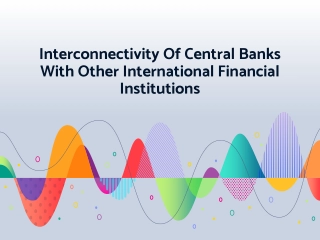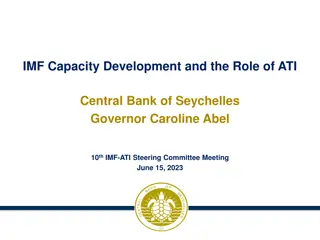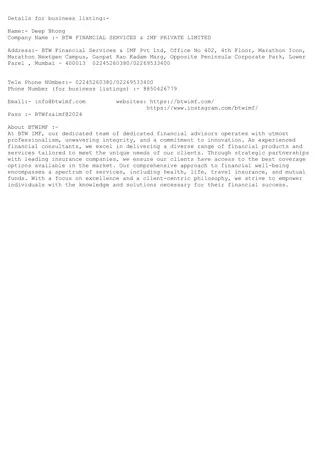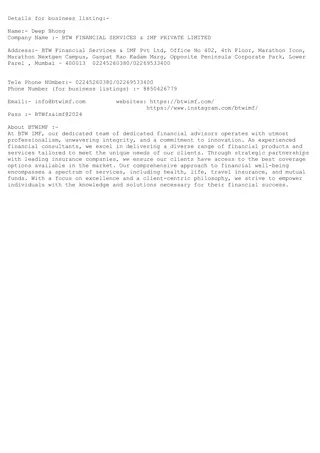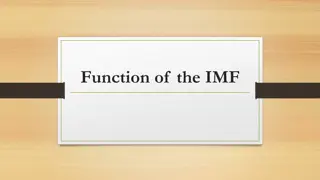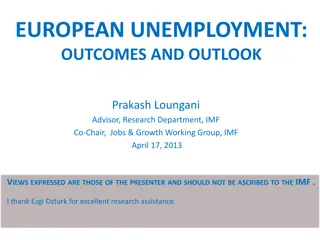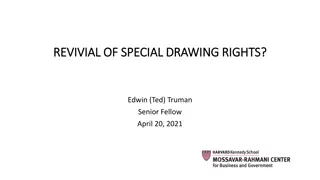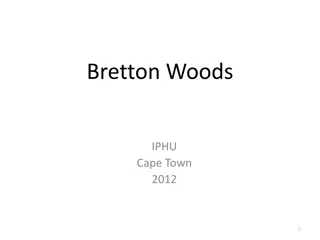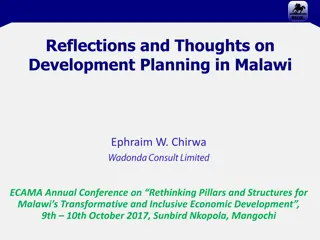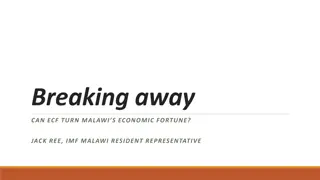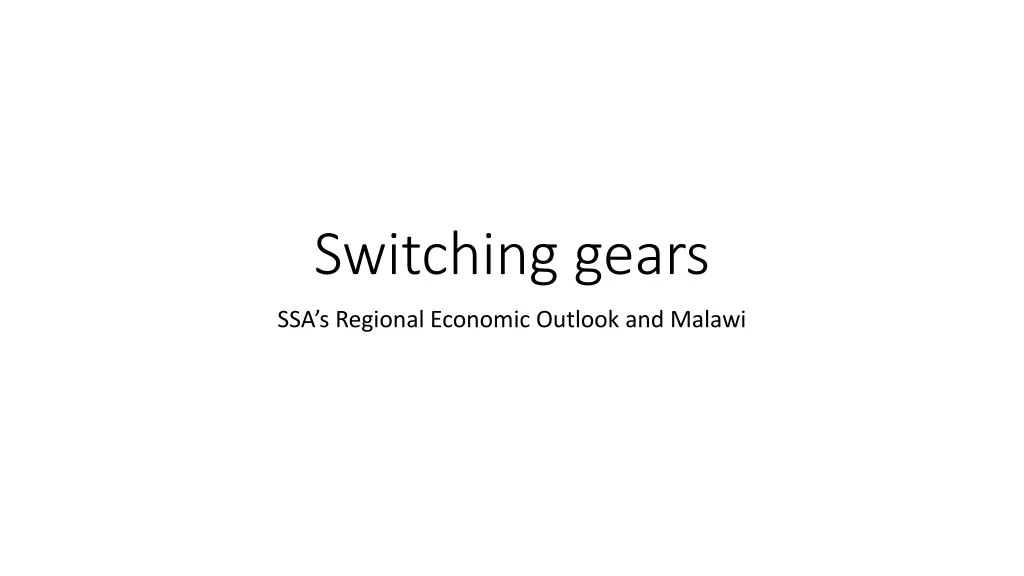
Sub-Saharan Africa Regional Economic Outlook Highlights
Explore the regional economic outlook of Sub-Saharan Africa, focusing on key indicators such as GDP growth, inflationary pressures, financing conditions, exchange rates, and fiscal deficits. Discover how growth has picked up but remains subdued, how inflationary pressures are receding, and how easier financing conditions are impacting frontier economies in the region. Dive into the developments in various sub-Saharan African countries and stay informed about the evolving economic landscape in the region.
Download Presentation

Please find below an Image/Link to download the presentation.
The content on the website is provided AS IS for your information and personal use only. It may not be sold, licensed, or shared on other websites without obtaining consent from the author. If you encounter any issues during the download, it is possible that the publisher has removed the file from their server.
You are allowed to download the files provided on this website for personal or commercial use, subject to the condition that they are used lawfully. All files are the property of their respective owners.
The content on the website is provided AS IS for your information and personal use only. It may not be sold, licensed, or shared on other websites without obtaining consent from the author.
E N D
Presentation Transcript
Switching gears SSA s Regional Economic Outlook and Malawi
Quest for growth SSA s Regional Economic Outlook
Growth has picked up, but is set to remain Growth has picked up, but is set to remain subdued subdued 8 Sub-Saharan Africa 7 Sub-Saharan Africa excluding Nigeria and South Africa Real GDP growth, percent 6 5 4 3 2 1 0 2013 2014 2015 2016 2017 proj. 2018 proj. 2019 proj. 3 Developments in sub-Saharan Africa
Inflationary pressures are receding Inflationary pressures are receding 14 13 Percent change, weighted average, year over year Headline Food Nonfood 12 11 10 9 8 7 6 5 4 Jan-12 Sep-12 May-13 Jan-14 Sep-14 May-15 Jan-16 Sep-16 May-17 4 Developments in sub-Saharan Africa
Easier financing conditions have brought frontier Easier financing conditions have brought frontier economies back to the market economies back to the market 1,100 Sub-Saharan African frontier market international bond 8 Sub-Saharan African non-oil exporters Sub-Saharan African oil exporters International sovereign bond issuances, bllions of US dollars 1,000 7 900 6 800 spreads, basis points 5 700 4 600 3 500 2 400 1 300 200 0 Jan-11 Sep-12 May-14 Jan-16 Sep-17 2011 2013 2015 2017:Q2 5 Developments in sub-Saharan Africa
Exchange rate pressures have eased in many Exchange rate pressures have eased in many countries countries the case of Nigeria the case of Nigeria 550 Interbank market Nigerian exchange rates, Naira per US dollar 500 Parallel rate Official Rate 450 400 350 300 250 200 150 Jan-15 May-15 Sep-15 Jan-16 May-16 Sep-16 Jan-17 May-17 Sep-17 6 Developments in sub-Saharan Africa
Fiscal deficits are stabilizing Fiscal deficits are stabilizing Other resource- intensive countries Non-resource- intensive countries Oil exporters 2 2 2 Interquartile range Median Interquartile range Median Interquartile range Median 1 1 1 Overall fiscal balance, percent of GDP 0 0 0 -1 -1 -1 -2 -2 -2 -3 -3 -3 -4 -4 -4 -5 -5 -5 -6 -6 -6 -7 -7 -7 -8 -8 -8 2011 2013 2015 2017 2011 2013 2015 2017 2011 2013 2015 2017 7 Developments in sub-Saharan Africa
Current account balances have improved Current account balances have improved 20 Trade balance Primary income (net) Current account balance Services (net) Net transfers Current account balance, percent of GDP 15 10 5 0 -5 -10 -15 Other resource-intensive countries Non-resource-intensive countries Oil exporters -20 Avg. 2011 13 2014 2015 2016 2017 proj. Avg. 2011 13 2014 2015 2016 2017 proj. Avg. 2011 13 2014 2015 2016 2017 proj. 8 Developments in sub-Saharan Africa
What actions? What actions? Addressing debt vulnerabilities Emphasis on revenue mobilization Fostering economic diversification 9 Developments in sub-Saharan Africa
Fiscal consolidation plans need to be Fiscal consolidation plans need to be implemented implemented Other resource- intensive countries Non-resource- intensive countries Oil exporters 100 100 100 No adjustment Baseline No adjustment Baseline No adjustment Baseline 90 90 90 Median public debt, percent of GDP 80 80 80 70 70 70 60 60 60 50 50 50 40 40 40 30 30 30 20 20 20 10 10 10 2011 2014 2017 2020 2011 2014 2017 2020 2011 2014 2017 2020 Fostering economic diversification Emphasis on revenue mobilization Addressing debt vulnerabilities 10
Fiscal multipliers are lower in SSA Fiscal multipliers are lower in SSA Impact on GDP growth of a 1 pp increase in Consumption-to-GDP ratio Investment-to-GDP ratio Revenue-to-GDP ratio 1.2 1.2 1.2 1.0 1.0 1.0 0.8 0.8 0.8 0.7 Real GDP growth, percent 0.6 0.6 0.6 0.5 0.4 0.4 0.4 0.2 0.2 0.2 0.0 0.0 0.0 0.2 0.2 0.2 0.2 0.4 0.4 0.4 0.6 0.6 0.6 0 1 2 3 4 5 0 1 2 Years 3 4 5 0 1 2 Years 3 4 5 Years Fostering economic diversification Emphasis on revenue mobilization Addressing debt vulnerabilities 11
Significant potential for raising revenues 25 Actual tax Tax potential 20 Tax ratio, percent of GDP 15 10 5 0 Oil Resource- intensive countries Non-resource intensive countries exporter Emphasis on revenue mobilization 12 Addressing debt vulnerabilities Fostering economic diversification
Diversification offers a path to growth 15 SSA oil exporters SSA non-resource-intensive SSA other resource-intensive Other countries GDP per capita growth, 1962 2014 percent GNQ 10 BWA 5 UGA 0 -5 0 1 2 3 4 5 6 7 Average export diversification, 1962 2014 (Higher values = less diversification) Fostering economic diversification Addressing debt vulnerabilities Emphasis on revenue mobilization 13
Getting the policy mix right and playing to your strengths Botswana: Expanding along the value chain Uganda: Moving into manufacturing Built on an existing position in the diamond industry Expanded from agro-commodities to agro-processing Helped to create positive spillovers to supporting sectors Industrial clusters supported exports of light manufacturing Strong record of good governance Sustained macroeconomic stability Prudent economic management Expanding regional trade supported export growth 14 Fostering economic diversification Addressing debt vulnerabilities Emphasis on revenue mobilization
Malawis outlook in the regional context How are we doing among the peers? What now? 15
Where are we? That was then: Fiscal deficits Weak growth Money Printing Inflation and deprecia tion Investor retrench ment
Not really winning the war: Actual vs. Projected Inflation A sinking sand? 30 20 10 0 2012 1st review 3rd and 4th reviews 7th and 8th reviews Actual 2013 2014 2015 2016 2017 2nd review 5th and 6th reviews 9th review
Stuck! - A deadly loop: Kwacha/USD 800 250 Kwacha s freefall Feedbacks 700 200 600 500 150 400 100 300 200 50 100 0 0 2012q4 2013q2 2013q4 2014q2 2014q4 2012q2 2009Q2 2009Q4 2010Q2 2010Q4 2011Q2 2011Q4 2015Q2 2015Q4 2016Q2 2016Q4 Kwacha/USD (avg) CPI (RHS)
How are we doing among the peers? How are we doing among the peers? Not bad. And that means not good either. 19
Growth Heading for a rebound? 9.0 Malawi 8.0 7.0 SSA-low income 6.0 5.0 4.0 SSA-all 3.0 2.0 SSA-middle 1.0 0.0 2004 08 2009 2010 2011 2012 2013 2014 2015 2016 2017 2018 20
Growth But more is needed for convergence Income Convergence? 7.0 6.0 5.0 4.0 3.0 2.0 1.0 0.0 2004-11 2012-16 2017-18 Sub-Saharan Africa Middle-income countries Low-income countries Of which: Malawi 21
Inflation Lights out of the tunnel Inflation 30.0 25.0 20.0 15.0 10.0 5.0 0.0 2004 08 2009 2010 2011 2012 2013 2014 2015 2016 2017 2018 22
Inflation Out of the haunted house! Inflation: a haunted house? 25.0 20.0 15.0 10.0 5.0 0.0 2004-11 2012-16 2017-18 Sub-Saharan Africa Middle-income countries Low-income countries Of which: Malawi 23
A macroeconomic window of opportunity This is now: Kwacha stable Investor confide nce Single digit inflation IMF/WB assessm ent Growth is back
What now? Macro economic policy Infrastructure financing Private investment
Macroeconomic policy First win this war And gradually switch policy gears
Infrastructure financing Plan how to merry flagship infrastructure projects with a sustainable fiscal planning Know your fiscal space and utilize it efficiently a simple principle for turning a vision into a plan
Unlocking private investment Listen to what they say. Bring on structural reform some meats please
Thank you! The online edition of the Regional Economic Outlook for sub-Saharan Africa is now available online at www.imf.org 29
Debt stocks have risen throughout the region Debt stocks have risen throughout the region Non-resource- intensive countries Other resource- intensive countries Oil exporters 70 70 70 Interquartile range Median Interquartile range Median 60 60 60 Public debt, percent of GDP 50 50 50 40 40 40 30 30 30 Interquartile range Median 20 20 20 10 10 10 2011 2013 2015 2017 2011 2013 2015 2017 2011 2013 2015 2017 Addressing debt vulnerabilities 31 Emphasis on revenue mobilization Fostering economic diversification
Driven by large fiscal deficits and depreciation Driven by large fiscal deficits and depreciation Addressing debt vulnerabilities Emphasis on revenue mobilization Fostering economic diversification 32
Debt service costs have increased Debt service costs have increased 30 Interquartile range Sub-Saharan Africa median Oil exporters median Total debt service, percent of revenue 25 20 15 10 5 0 2010 2011 2012 2013 2014 2015 2016 2017 proj. 33 Addressing debt vulnerabilities Emphasis on revenue mobilization Fostering economic diversification
Fiscal pressures pose risks to an already Fiscal pressures pose risks to an already weakened financial sector weakened financial sector 30 Bank nonperforming loans, percent of total loans 2013 25 2017:Q1 or latest available 20 15 10 5 0 RWA SWZ BWA MUS MOZ BDI GHA MDG NGA UGA CMR GAB COG CAF NER TCD GNQ NAM AGO SEN KEN LBR ZAF LSO SLE TZA SYC GIN Resource-intensive countries Non-resource-intensive countries Emphasis on revenue mobilization Fostering economic diversification Addressing debt vulnerabilities 34

